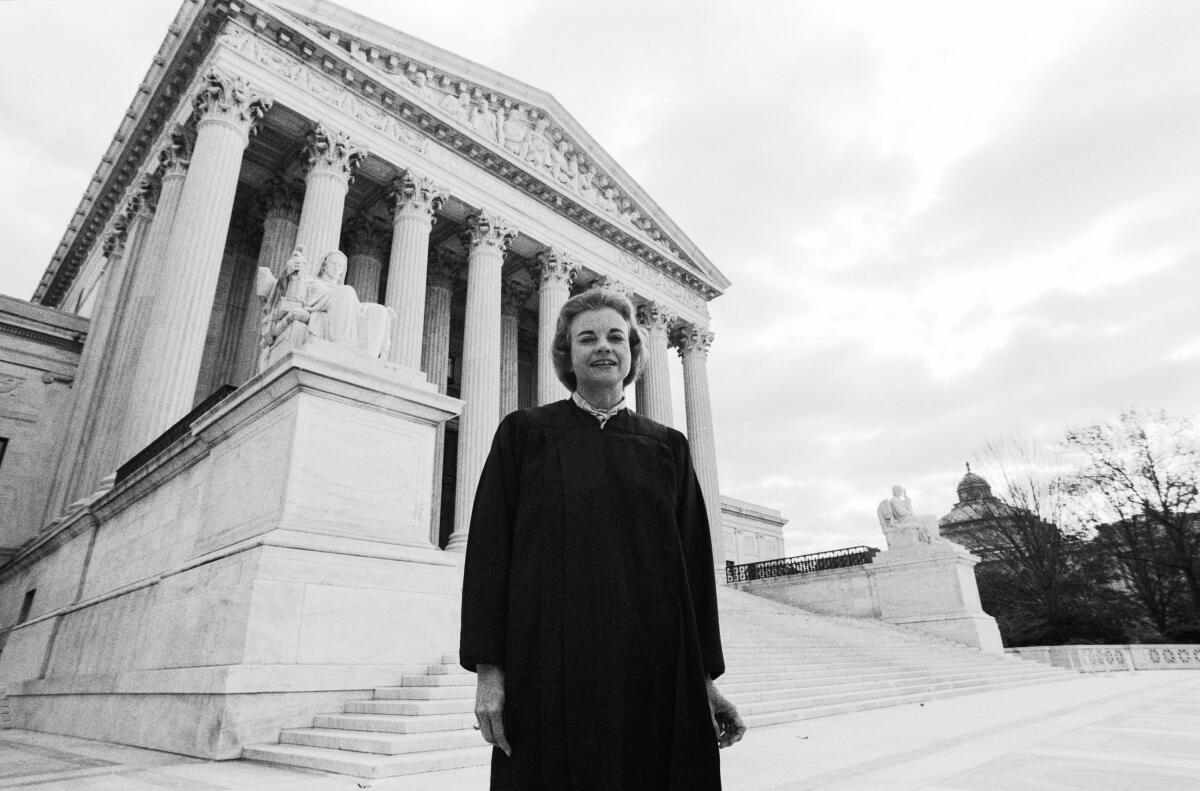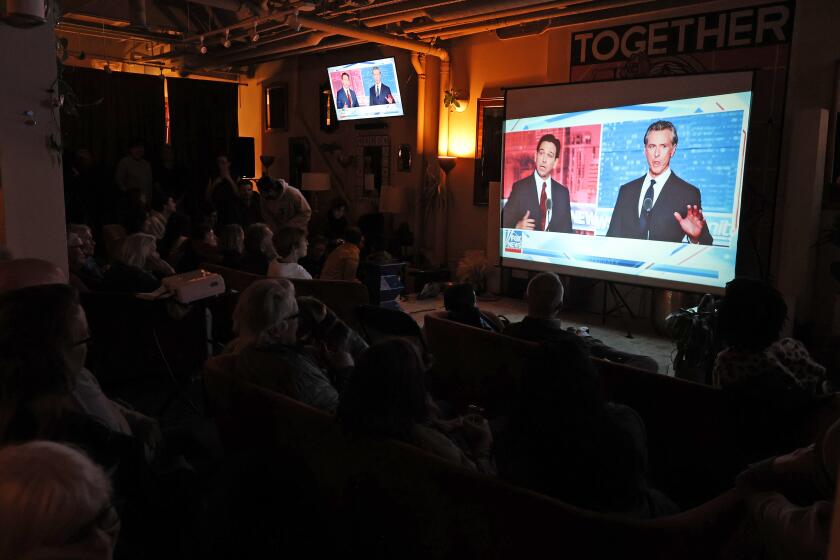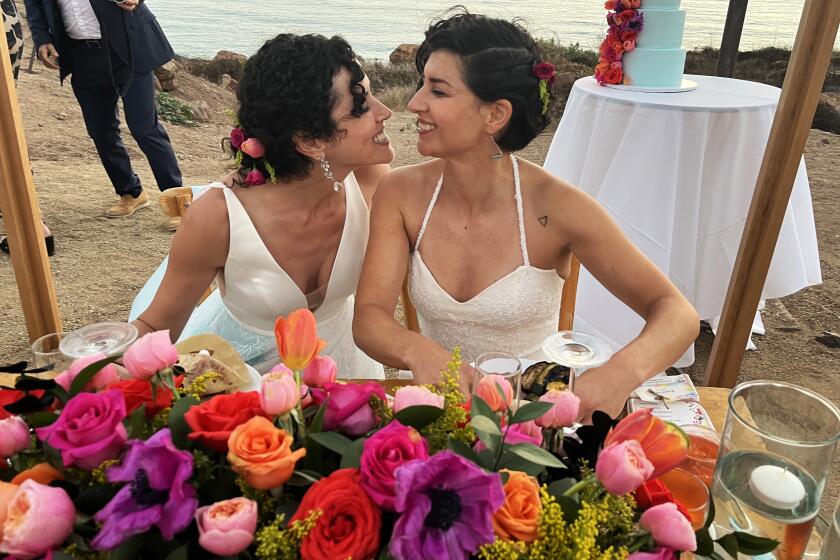Column: I thought Sandra Day O’Connor was too conservative. Now her moderation would be a godsend

Years ago, I had the good fortune to be in Washington, when the National Portrait Gallery had a show starring portraits of Supreme Court Justice Sandra Day O’Connor, who died Friday in Phoenix at 93.
In October 2006, nine or so months after she’d stepped down from the high court, O’Connor had agreed to sit for members of the Painting Group, two dozen or so artists who had been meeting to paint a different person each week since 1958.
“In 20-minute intervals from 9 to 5 (with five-minute breaks in between and time for lunch),” reported the New York Times, “she told stories about her childhood and sat very still.”
The 25 portraits that emerged from that sitting were as wonderful as they were varied. Seventy-seven years old at the time she posed, the legal pioneer was depicted literally, figuratively, abstractly. But every portrait, regardless of style, exuded integrity, decorum and even a sort of inscrutability, all aspects of the measured temperament she brought to the court.
(Perhaps it was this part of her personality, her self-containment, that led to the infamous moment in 1985 when a very drunk running back with Washington’s NFL team, John Riggins, told her during a press club banquet to “Loosen up, Sandy baby.”)
For her portrait sitting, she wore her black judge’s robe, with her signature white jabot tumbling from her throat. Later, that lacy accent would come to symbolize the great women’s advocate Ruth Bader Ginsburg, the second woman to be appointed to the Supreme Court.
But before RBG, there was SDO.
A red state governor and a blue state governor, only one of whom is running for president, met in a Fox News publicity stunt.
Her relatively moderate positions on issues like abortion, affirmative action, sex discrimination and voting rights put her at the center of power in the court, toggling between its left and right factions. Having voted in some earlier cases to limit the absolute right to abortion, she provided the crucial vote in 1992’s Planned Parenthood vs. Casey, which upheld Roe vs. Wade but allowed states to enact restrictions that do not impose an “undue burden” on the woman.
Requiring a married woman to formally inform her husband of her decision to end a pregnancy, for example, was not just an undue burden, but, wrote O’Connor, “repugnant to this Court’s present understanding of marriage and the nature of the rights secured by the Constitution.”
Her judicial philosophy was based in pragmatism, not ideology.
Believe Donald Trump when he tells us what he’d do with another White House term: eliminate civil service job protections, jail his political enemies and spit on the Constitution.
“Justice O’Connor,” wrote her biographer Evan Thomas, “had an intuitive feel for the public mood. She did not need to read polls to know that, although some people are either for or against abortion as an absolute matter, more people have a less certain or determined view. She knew that there were many women like her, unwilling to have an abortion but also reluctant to tell other women to make the same choice.”
She softened on the issue of affirmative action, recognizing that she herself was a beneficiary of the practice.
“Once,” wrote Thomas, “during the Court’s weekly private conference, when Justice Antonin Scalia was declaiming against racial and gender preference, O’Connor dryly remarked, ‘Why Nino, how do you think I got my job?’ ”
In the 1980s and ‘90s, O’Connor sided with the court’s conservatives in decisions that outlawed the use of race in creating majority Black congressional districts and restricted the use of quota-like “set asides” for minority contractors. But years later, in 2003, she provided the crucial vote allowing universities to favor racial minorities in their admissions procedures.
(The current court, in its zeal to turn back the clock on racial and gender advances, has struck down the constitutional right to abortion and has outlawed race-conscious admissions programs that colleges have used to increase the number of minority students.)
It’s in Los Angeles’ civic DNA to catastrophize about traffic headaches. Blocked freeways are bad, and then they fade into legend.
I probably did not appreciate O’Connor enough when she was on the court. She was, to my thinking, too conservative. In retrospect, what a moderate!
I thought it was an entirely mainstream view — a no-brainer! — that displaying the Ten Commandments at courthouses in Kentucky violated the 1st Amendment’s implicit separation of church and state. I thought her concurring opinion on it wasn’t remarkable: “Those who would renegotiate the boundaries between church and state must therefore answer a difficult question: Why would we trade a system that has served us so well for one that has served others so poorly?” she wrote. Yet four of her colleagues voted to allow the display. And now? God (and the ACLU) only knows how the current Christianist, Republican-appointed majority would rule on such a case.
My opinion of her bottomed out in 2000, when she and her conservative colleagues essentially awarded the presidency to Republican George W. Bush by refusing to allow Florida to continue recounting votes. I was happy to see that she later came to regret that ruling, telling the Chicago Tribune editorial board in 2013 that the episode “gave the court a less-than-perfect reputation.” That’s putting it mildly. That moment was a shocking display of the kind of partisanship that plagues the court today.
A new anti-gay-marriage push, energized by the overturning of abortion rights, is trying to make Americans believe the institution of marriage is diminished by same-sex unions.
In 2018, O’Connor announced that she would be stepping back from public life. She’d been diagnosed with dementia, “probably Alzheimer’s disease,” and foresaw a difficult road ahead.
“While the final chapter of my life with dementia may be trying, nothing has diminished my gratitude and deep appreciation for the countless blessings in my life,” she wrote. “I never could have imagined that one day I would become the first woman justice on the U.S. Supreme Court.”
Like many moderate Republicans, O’Connor would be considered liberal by today’s standards. She was very unhappy that the ultraconservative Samuel A. Alito Jr. had replaced her after she retired to care for her husband, who was in the throes of Alzheimer’s disease and died in 2009.
That year, she was asked how she felt about her rulings being reversed by the increasingly right-wing court. “What would you feel?” she replied.
As important as her moderating influence on the court was, her 1981 appointment by President Reagan, made to fulfill a campaign promise, was a singularly important moment for American women in the law.
“The minute I was confirmed and on the court, states across the country started putting more women ... on their Supreme Courts,” O’Connor said. “And it made a difference in the acceptance of young women as lawyers. It opened doors for them.”
It turns out that the historic career of Sandra Day O’Connor is proof positive that affirmative action, for all its bad press, can actually work.
More to Read
A cure for the common opinion
Get thought-provoking perspectives with our weekly newsletter.
You may occasionally receive promotional content from the Los Angeles Times.
















